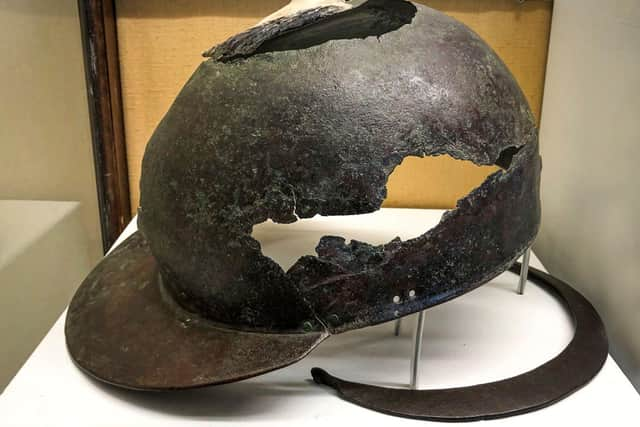Fishbourne Roman Palace’s helmet leaving experts baffled
and live on Freeview channel 276
The helmet known as the Oyster Helmet of Chichester, is believed to have been produced in the first century AD predating the Roman conquest of Britain. It is just one of four Coolus helmets in the UK.
It was acquired by the Sussex Archaeological Society in 1893, and though much of its journey has been lost to history. It is thought to have been found in the mud flats at Chichester Harbour.
Advertisement
Hide AdAdvertisement
Hide AdSEE ALSO: Cultural celebration gets ready to launch in the district with free events in Chichester, Midhurst and SelseySarah Parker, property manager at Fishbourne Roman Palace, said: “It is surprising to find these items in a pre-Roman context, and we hope visitors to the exhibition enjoy playing detective. While we may not have enough archaeological evidence to suggest that the Roman invasion of Britain took place earlier than previously thought, there are a lot of questions to be answered.”


“What we do have significant evidence of is a link between Iron Age communities in Sussex and the Romans – they could have been trading, training warriors, or even, though it’s unlikely, capturing Romans.
“So, how did the helmet get here, and who wore it? Well, it could have been collected by an antiquarian in Europe centuries after the Romans, and then lost overboard. It could be that a Roman soldier had kept his Coolus helmet even after newer helmet designs had replaced it. Maybe a local person had acquired and had decided to dress in Roman gear, we just don’t know.
“We know that the helmet was mass-produced, made cheaply for a lower status soldier, because it has very few decorations and was ‘spun’ on a lathe. It almost certainly wasn’t made in Rome. It could even be that this helmet was worn by an enslaved person, perhaps someone from Gaul, a region that spanned across modern Europe.”
Advertisement
Hide AdAdvertisement
Hide AdOther pre-invasion artefacts including a sword scabbard fitting and an Iron Age crucible will also be on display at the Roman Palace.
The scabbard fitting, which, like the Chichester Helmet, is made of copper alloy, sparks further debate. Though it is Roman, it was found in an Iron Age ditch and dates to before the Roman invasion. The crucible offers yet more evidence of Iron Age Britons having interacted with the Romans pre-invasion. It is an iron age artefact, but contains brass – a material whose production was a secret known only to the Roman army at the time.
The Oyster Helmet will be on display at Fishbourne Roman Palace from early April and throughout the spring and summer seasons in 2022.